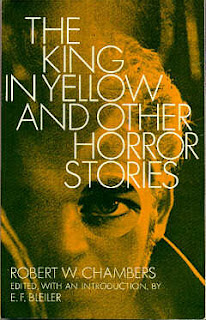After a slight dip in quality in the second volume, the
Fontana Book of Great Ghost Stories is back with a “Boo”! Even Robert Aickman’s introduction has more
zest. Aickman writes that “As an
antidote to daily living in a compulsorily egalitarian society, a good ghost
story… can bring real joy.” He attempts
to define a good ghost story as one that opens a door and leaves it ajar at the
end of the story, perhaps referring to his own open-ended tales.
E.F. Benson, celibate son of an Archbishop of Canterbury,
leads off the collection with Negotium
Perambulans, in which a similarly celibate narrator returns to the idyllic Cornish
town of his youth to encounter an ambiguous creature which, though not very
pleasant itself, preys on the wicked.
Benson wrote many excellent supernatural stories, and this is among
them.
“There he lay a-dying,” said the last of my informants, “and
him that had been a great burly man was withered to a bag o’ skin, for the
critter had drained all the blood from him.
His last breath was a scream…”
The End of the Flight,
by Somerset Maugham, involves a man pursued around Malaysia by another bent on
revenge. Supernatural elements are
hardly even suggested, but the story does leave the door ajar at the end.
The next 71 pages are deservedly taken up by Oliver Onions’ The Beckoning Fair One. It is one of the best ghost stories. Aickman says it best in his
introduction: “An almost perfect story,
its perfection is the more impressive by reason of the unusual but
indispensable length to which it is sustained.”
The Dream, by A.J.
Alan, is a simple story, but it’s told in such a straightforward, avuncular way
that it is impossible to dislike. Alan’s
conversational style served him well, as he broadcast his stories on the BBC
from 1924-1940. My guess is that this
one may also have begun as a radio broadcast.
I didn’t care for The
Stranger, by Hugh MacDiarmid (known more for his poetry). It’s the tale of a possibly-unearthly
stranger in a pub, which like Alan’s story preceding it could be summed up in a
few sentences. Here, however, MacDiarmid
doesn’t create the atmosphere needed for such simplicity to work.
The Case of Mr.
Lucraft, by Sir Walter Besant and James Rice, who wrote together from
1871-1882, is highly enjoyable. I
appreciate the fact that in these Fontana anthologies Aickman selected some
completely unique premises, and this is one of them. The unfortunate Mr. Lucraft, narrating from
advanced years, takes us through his early life when he bargained away his appetite
to the sinister Mr. Grumbelow:
“You will dip the pen,” said the old gentleman, “in the
blood. It is a mere form. A mere form, because we have no ink handy.”
Another unique story is The
Seventh Man, by Sir Arthur Quiller-Couch, which could have been a prototype
for Arctic (and Antarctic) horror to come:
“There, before him, on the frozen coat of snow, was a
footprint... many footprints. Prints of
a naked human foot: right foot, left foot, both naked, and blood in each print –
a little smear.”
No Ships Pass, by
Lady Eleanor Smith, is one of the few in this anthology I’ve read before. Maybe this is why it seemed on a second
reading a bit too lengthy for what it is; enjoyable, though, as a castaway
washes up onto an island and finds himself in a tropical version of No Exit.
The Man Who Came Back,
by William Gerhardi, might have benefitted from a less descriptive title, but
is a nicely written example of a concise and traditional ghost story.
Aickman finishes the collection with The Visiting Star, in which an ageless actress comes to perform in
a dull mining town in the middle of winter. I greatly enjoy Aickman, and hadn’t come across
this story before. As is often the case
with his works, The Visiting Star is
understated, somewhat rambling, and leaves much open to interpretation.
So, Aickman has selected a wide range of atmospheric supernatural
stories here; some are frequently anthologized, some rarely seen, but almost
all are highly entertaining.




